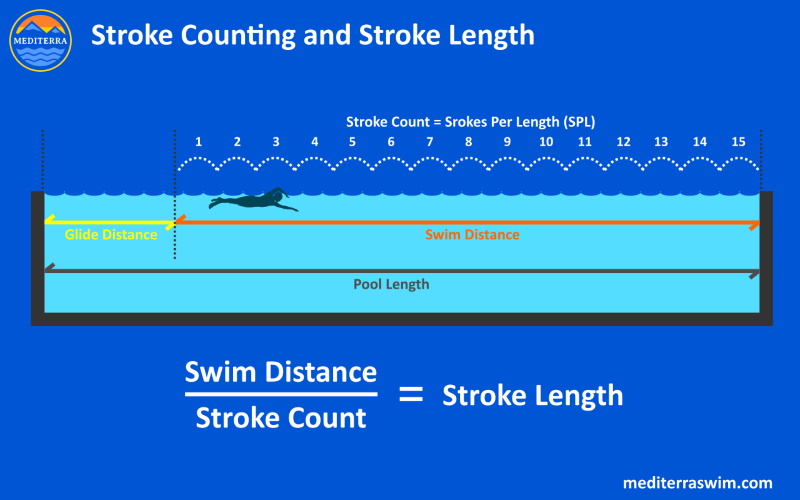Practice Set for Stroke Counting
As you are getting acquainted with stroke counting, you may try these practice ideas to gradually increase how often you count or how much you can pay attention to when counting, while the counting is helping to build your strength and skill.
Practice Accurate Counting
The more attentive, accurate and honest you are in your counting, the more useful it will be for helping you monitor your progress.
As you approach the end of the lane, you may find that you might not need a full stroke to reach the wall or that you might need to glide a bit farther to reach the wall (rather than take one more stroke). If you’d like to be more accurate in your counting, then add this ‘half’ stroke unit into your counting – some lengths you may find that you don’t end on a whole number but need ½ half more or less of a stroke to reach the wall.
Maintain the exact same push off intensity and glide distance to your first stroke.
Swim 4x 25
- First length count strokes
- Second and third length do not count, and focus on your cue
- Fourth length count stroke
Swim a chosen distance and count strokes on only every 4th length.
Swim a chosen distance and count strokes on every other length.
Practice Consistent Count
The first strength that stroke counting can help you build is to learn to swim with the same exact stroke count on every length, even as you get farther into the swim or practice and start to feel some fatigue – this will push you to increase strength and skill.
Most often swimmers will find they naturally use 1 less stroke on their first length of a swim. So, the challenge here is to practice maintaining that same level of skillfulness and strength on the second length, or practice restraining any over-effort on the first length so that it matches what you are capable of on the following lengths.
Swim 8x 25 and aim to hold the exact same stroke count on every 25.
Swim 4x 50 and aim to hold the exact same stroke count on first and second lengths.
Swim 4x 75 and aim to hold the exact same stroke count on all three lengths.
Practice Shifting Stroke Count “Gears”
The more you count strokes and get a feel for what your current ‘normal’ (N) stroke count is (which reflects your current strength and skillfulness) the more you can memorize what it feels like in your stroke to be on the way toward a precise stroke count result. You may possibly come to know, by feel, when you are swimming, for example, an ‘18-count length’ or a 19-count length’ before you even get to the wall and finish counting! When you are doing long swims and don’t want to count all the time or swimming in open water, you may be able to estimate your own stroke count just by how it feels, because you have done it so much attentively.
The next step is to learn how to adjust your stroke count with precision, like shifting gears on a bicycle. You can practice ‘shifting up’ one number or ‘shifting down’ one number. This will help you develop more familiarity and control over the features of the stroke that directly affect your stroke length (count).
Choose your normal stroke count ‘N’. Swim 4x 25 and aim to shift the stroke count ‘gear’ a certain amount on each length:
- First length: N
- Second length: N+1
- Third length: N
- Fourth length: N-1
Practice Stretching Your Stroke Count
As your strength and skills improve your stroke length should naturally increase (you slide farther on each stroke). This means your stroke count should go down, approaching what would be an optimal count for your body and event (or purpose for swimming). While it might be tempting to try to reach for a really long stroke (a really low stroke count) right at the start, this is not recommended for many reasons, the foremost being the safety of your body. Instead, you may engage in a small, gradual challenge to your strength and skill which will give your body more time to adapt to this.
Choose your normal stroke count ‘N’. Swim 3x 100 (4x 25) and aim to shift the stroke count from N to N-1 for greater % of the swim.
First 100
- 75 at N count
- 25 at N-1
Second 100
- 50 at N count
- 50 at N-1
Third 100
- 25 at N count
- 75 at N-1
You can follow the same pattern for a swim of any distance…
- First swim aim for 75% N count and 25% N-1.
- Second swim aim for 50% N count and 50% N-1.
- Third swim aim for 25% N count and 75% N-1.

